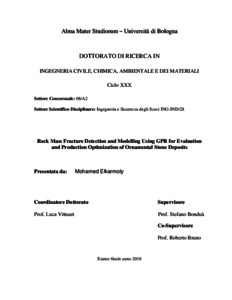Elkarmoty, Mohamed Mohy Mohamed Saad
(2018)
Rock Mass Fracture Detection and Modelling Using GPR for Evaluation and Production Optimization of Ornamental Stone Deposits, [Dissertation thesis], Alma Mater Studiorum Università di Bologna.
Dottorato di ricerca in
Ingegneria civile, chimica, ambientale e dei materiali, 30 Ciclo. DOI 10.6092/unibo/amsdottorato/8370.
Documenti full-text disponibili:
![[img]](http://amsdottorato.unibo.it/8370/1.hassmallThumbnailVersion/Thesis_Mohamed%20Elkarmoty_PhD%20UNIBO.pdf)  Anteprima |
|
Documento PDF (English)
- Richiede un lettore di PDF come Xpdf o Adobe Acrobat Reader
Disponibile con Licenza: Salvo eventuali più ampie autorizzazioni dell'autore, la tesi può essere liberamente consultata e può essere effettuato il salvataggio e la stampa di una copia per fini strettamente personali di studio, di ricerca e di insegnamento, con espresso divieto di qualunque utilizzo direttamente o indirettamente commerciale. Ogni altro diritto sul materiale è riservato.
Download (11MB)
| Anteprima
|
Abstract
The thesis presents new solutions for the fractures problem in ornamental stone quarries which entails economic and material loses. The thesis aimed at developing methodologies and providing solutions for evaluation and production optimization of ornamental stone deposits. Ground Penetrating Radar (GPR) was selected, among several methods, as a fracture detection tool for this research. A combination of the use of a low frequency GPR antenna and laboratory rock tests for evaluation of an ornamental stone deposit showed encouraging results. Based on GPR survey, particularly high frequency antennas, a 3D deterministic fracture modeling approach was developed and implemented in several case studies of block and bench scales. A fracture index was proposed for deposit evaluation based on fracture detections from GPR survey. Additionally, an in-situ GPR test allowed formulating a propagation velocity model for 3D mapping of the dielectric constant of the medium, within macro and micro scale of the rock mass of a bench in a sandstone quarry. This finding is significant for future improvement of the deterministic accuracy level of the developed fracture modeling approach and, generally, for the GPR applications in rock mass. Regarding quarrying optimization, two 3D algorithms, based on fracture modeling or mapping, were developed for production and/or revenue optimization of cutting slabs from blocks and cutting blocks from benches. The algorithms were coded in two software packages named SlabCutOpt and BlockCutOpt. SlabCutOpt was applied to a case study of a limestone block through testing 37 different commercial-sizes of slabs, investigating the optimization results in terms of recovery ratio (a geo-environmental direction) and revenue (an economic direction). BlockCutOpt was applied to two case studies (quarries) with different site characteristics. The results showed that optimum cutting direction of blocks can vertically and horizontally vary, giving geometric information about the cutting grid of blocks that optimizes the production.
Abstract
The thesis presents new solutions for the fractures problem in ornamental stone quarries which entails economic and material loses. The thesis aimed at developing methodologies and providing solutions for evaluation and production optimization of ornamental stone deposits. Ground Penetrating Radar (GPR) was selected, among several methods, as a fracture detection tool for this research. A combination of the use of a low frequency GPR antenna and laboratory rock tests for evaluation of an ornamental stone deposit showed encouraging results. Based on GPR survey, particularly high frequency antennas, a 3D deterministic fracture modeling approach was developed and implemented in several case studies of block and bench scales. A fracture index was proposed for deposit evaluation based on fracture detections from GPR survey. Additionally, an in-situ GPR test allowed formulating a propagation velocity model for 3D mapping of the dielectric constant of the medium, within macro and micro scale of the rock mass of a bench in a sandstone quarry. This finding is significant for future improvement of the deterministic accuracy level of the developed fracture modeling approach and, generally, for the GPR applications in rock mass. Regarding quarrying optimization, two 3D algorithms, based on fracture modeling or mapping, were developed for production and/or revenue optimization of cutting slabs from blocks and cutting blocks from benches. The algorithms were coded in two software packages named SlabCutOpt and BlockCutOpt. SlabCutOpt was applied to a case study of a limestone block through testing 37 different commercial-sizes of slabs, investigating the optimization results in terms of recovery ratio (a geo-environmental direction) and revenue (an economic direction). BlockCutOpt was applied to two case studies (quarries) with different site characteristics. The results showed that optimum cutting direction of blocks can vertically and horizontally vary, giving geometric information about the cutting grid of blocks that optimizes the production.
Tipologia del documento
Tesi di dottorato
Autore
Elkarmoty, Mohamed Mohy Mohamed Saad
Supervisore
Co-supervisore
Dottorato di ricerca
Ciclo
30
Coordinatore
Settore disciplinare
Settore concorsuale
Parole chiave
GPR; Fracture modeling; Ornamental stone; Quarrying; Deposit evaluation; Production optimization
URN:NBN
DOI
10.6092/unibo/amsdottorato/8370
Data di discussione
11 Maggio 2018
URI
Altri metadati
Tipologia del documento
Tesi di dottorato
Autore
Elkarmoty, Mohamed Mohy Mohamed Saad
Supervisore
Co-supervisore
Dottorato di ricerca
Ciclo
30
Coordinatore
Settore disciplinare
Settore concorsuale
Parole chiave
GPR; Fracture modeling; Ornamental stone; Quarrying; Deposit evaluation; Production optimization
URN:NBN
DOI
10.6092/unibo/amsdottorato/8370
Data di discussione
11 Maggio 2018
URI
Statistica sui download
Gestione del documento:


 Login
Login
